Comprehensive Benefit Analysis of Port Shore Power Based on Carbon Trading
Abstract
1. Introduction
2. Electricity Substitution Multiagent Game Model
2.1. Multiagent Game Analses
2.2. Assumptions
- The government stipulates carbon emission caps or implements carbon tax policies for ports;
- The created carbon emissions belong to the port once the ship has berthed there.
2.3. Methodology
2.4. Parameter Descriptions
3. Game Research under Two Carbon Mechanism
3.1. Game Research on the Use of Shore Power under Cap and Trade
- 1.
- Government Benefit Analysis Model
- 2.
- Port Benefit Analysis Model
- 3.
- Ship Benefit Analysis Model
3.2. Game Researches on the Use of Shore Power under the Carbon Tax Policy
- 1.
- Government Benefit Analysis Model
- 2.
- Port Benefit Analysis Model
- 3.
- Ship Benefit Analysis Model
4. Data Selection
4.1. Government Data Acquisition
4.2. Port Data Acquisition
4.3. Ship Data Acquisition
4.4. Electricity Price Acquisition
4.5. Pollutant Data Acquisition
4.6. Carbon Price Data Acquisition
5. The Impact of Various Factors on the Benefits of Each Party
5.1. Comparison of the Impact of Subsidy Rates
5.2. Carbon Price Impact Comparisons
5.3. Comparison of Time-Proportional Effects of Using Shore Power
6. Conclusions
Author Contributions
Funding
Data Availability Statement
Conflicts of Interest
References
- Handbook of Statistics 2021. In Proceedings of the United Nations Conference on Trade and Development. Available online: https://unctad.org/system/files/official-document/tdstat46_en.pdf (accessed on 6 February 2023).
- Review of Maritime Transport 2021. In Proceedings of the United Nations Conference on Trade and Development. Available online: https://unctad.org/publication/review-maritime-transport-2021 (accessed on 6 February 2023).
- Sheng, D.; Li, Z.-C.; Fu, X.; Gillen, D. Modeling the effects of unilateral and uniform emission regulations under shipping company and port competition. Transp. Res. E Logist. Transp. Rev. 2017, 101, 99–114. [Google Scholar] [CrossRef]
- Rolán, A.; Manteca, P.; Oktar, R.; Siano, P. Integration of cold ironing and renewable sources in the barcelona smart port. IEEE Trans. Ind. Appl. 2019, 55, 7198–7206. [Google Scholar] [CrossRef]
- Ballini, F.; Bozzo, R. Air pollution from ships in ports: The socio-economic benefit of cold-ironing technology. Res. Transp. Bus. Manag. 2015, 17, 92–98. [Google Scholar] [CrossRef]
- IMO 2020—Cutting Sulphur Oxide Emissions. Available online: https://www.imo.org/en/MediaCentre/HotTopics/Pages/Sulphur-2020.aspx (accessed on 1 August 2022).
- Corbett, J.; Winebrake, J.; Carr, E.; Jalkanen, J.; Johansson, L.; Prank, M.; Sofiev, M.; Winebrake, S.; Karppinen, A. Health impacts associated with delay of MARPOL global sulphur standards. In Air Pollution and Energy Efficiency; Annex II MEPC; International Maritime Organization: London, UK, 2016; Volume 70. [Google Scholar]
- Qi, J.; Wang, S.; Peng, C. Shore power management for maritime transportation: Status and perspectives. Marit. Transp. Res. 2020, 1, 100004. [Google Scholar] [CrossRef]
- Sofiev, M.; Winebrake, J.J.; Johansson, L.; Carr, E.W.; Prank, M.; Soares, J.; Vira, J.; Kouznetsov, R.; Jalkanen, J.-P.; Corbett, J.J. Cleaner fuels for ships provide public health benefits with climate tradeoffs. Nat. Commun. 2018, 9, 406. [Google Scholar] [CrossRef] [PubMed]
- Corbett, J.J.; Winebrake, J.J.; Green, E.H.; Kasibhatla, P.; Eyring, V.; Lauer, A. Mortality from ship emissions: A global assessment. Environ. Sci. Technol. 2007, 41, 8512–8518. [Google Scholar] [CrossRef]
- Chen, J.; Zheng, T.; Garg, A.; Xu, L.; Li, S.; Fei, Y. Alternative maritime power application as a green port strategy: Barriers in China. J. Clean. Prod. 2019, 213, 825–837. [Google Scholar] [CrossRef]
- Radwan, M.E.; Chen, J.; Wan, Z.; Zheng, T.; Hua, C.; Huang, X. Critical barriers to the introduction of shore power supply for green port development: Case of Djibouti container terminals. Clean Technol. Environ. Policy 2019, 21, 1293–1306. [Google Scholar] [CrossRef]
- Winkel, R.; Weddige, U.; Johnsen, D.; Hoen, V.; Papaefthimiou, S. Shore side electricity in Europe: Potential and environmental benefits. Energy Policy 2016, 88, 584–593. [Google Scholar] [CrossRef]
- Pettit, S.; Wells, P.; Haider, J.; Abouarghoub, W. Revisiting history: Can shipping achieve a second socio-technical transition for carbon emissions reduction? Transp. Res. D Transp. Environ. 2018, 58, 292–307. [Google Scholar] [CrossRef]
- Vaishnav, P.; Fischbeck, P.S.; Morgan, M.G.; Corbett, J.J. Shore power for vessels calling at US ports: Benefits and costs. Environ. Sci. Technol. 2016, 50, 1102–1110. [Google Scholar] [CrossRef] [PubMed]
- Sciberras, E.A.; Zahawi, B.; Atkinson, D.J. Electrical characteristics of cold ironing energy supply for berthed ships. Transp. Res. D Transp. Environ. 2015, 39, 31–43. [Google Scholar] [CrossRef]
- Peterson, K.L.; Islam, M.; Cayanan, C. State of shore power standards for ships. In Proceedings of the 2007 IEEE Petroleum and Chemical Industry Technical Conference, Calgary, AB, Canada, 17–19 September 2007; pp. 1–6. [Google Scholar]
- Lam, J.S.L.; Notteboom, T. The greening of ports: A comparison of port management tools used by leading ports in Asia and Europe. Transp. Rev. 2014, 34, 169–189. [Google Scholar] [CrossRef]
- Zis, T.; North, R.J.; Angeloudis, P.; Ochieng, W.Y.; Harrison Bell, M.G. Evaluation of cold ironing and speed reduction policies to reduce ship emissions near and at ports. Marit. Econ. Logist. 2014, 16, 371–398. [Google Scholar] [CrossRef]
- Styhre, L.; Winnes, H.; Black, J.; Lee, J.; Le-Griffin, H. Greenhouse gas emissions from ships in ports–Case studies in four continents. Transp. Res. D Transp. Environ. 2017, 54, 212–224. [Google Scholar] [CrossRef]
- Zhao, X.; Liu, L.; Di, Z.; Xu, L. Subsidy or punishment: An analysis of evolutionary game on implementing shore-side electricity. Reg. Stud. Mar. Sci. 2021, 48, 102010. [Google Scholar] [CrossRef]
- Wu, L.; Wang, S. The shore power deployment problem for maritime transportation. Transp. Res. E Logist. Transp. Rev. 2020, 135, 101883. [Google Scholar] [CrossRef]
- Song, T.; Li, Y.; Hu, X. Cost-effective optimization analysis of shore-to-ship power system construction and operation. In Proceedings of the 2017 IEEE Conference on Energy Internet and Energy System Integration (EI2), Beijing, China, 26–28 November 2017; pp. 1–6. [Google Scholar]
- Tseng, P.-H.; Pilcher, N. Evaluating the key factors of green port policies in Taiwan through quantitative and qualitative approaches. Transp. Policy 2019, 82, 127–137. [Google Scholar] [CrossRef]
- Drake, D.F.; Kleindorfer, P.R.; Van Wassenhove, L.N. Technology choice and capacity portfolios under emissions regulation. Prod. Oper. Manag. 2016, 25, 1006–1025. [Google Scholar] [CrossRef]
- Murray, B.; Rivers, N. British Columbia’s revenue-neutral carbon tax: A review of the latest “grand experiment” in environmental policy. Energy Policy 2015, 86, 674–683. [Google Scholar] [CrossRef]
- Ellerman, A.D.; Buchner, B. Over-Allocation or Abatement? A Preliminary Analysis of the EU Emissions Trading Scheme Based on the 2005 Emissions Data; MIT Joint Program on the Science and Policy of Global Change: Cambridge, MA, USA, 2006. [Google Scholar]
- Song, S.; Govindan, K.; Xu, L.; Du, P.; Qiao, X. Capacity and production planning with carbon emission constraints. Transp. Res. E Logist. Transp. Rev. 2017, 97, 132–150. [Google Scholar] [CrossRef]
- Liu, Y.; Xin, X.; Yang, Z.; Chen, K.; Li, C. Liner shipping network-transaction mechanism joint design model considering carbon tax and liner alliance. Ocean Coast. Manag. 2021, 212, 105817. [Google Scholar] [CrossRef]
- Chen, Z.-y.; Nie, P.-y. Effects of carbon tax on social welfare: A case study of China. Appl. Energy 2016, 183, 1607–1615. [Google Scholar] [CrossRef]
- Wang, C. Monopoly with corporate social responsibility, product differentiation, and environmental R&D: Implications for economic, environmental, and social sustainability. J. Clean. Prod. 2021, 287, 125433. [Google Scholar]
- Interim Measures of Shenzhen Municipality on the Administration of Subsidies for Ports, Ship Shore Power Facilities and Low Sulfur Oil for Ships. Available online: http://jtys.sz.gov.cn/jtzx/wycx/slcx/khzc/content/post_4302973.html (accessed on 1 August 2022).
- Ritchie, A.; de Jonge, E.; Hugi, C.; Cooper, D. European Commission Directorate General Environment, Service Contract on Ship Emissions: Assignment, Abatement, and Market-based Instruments. In Task 2c–SO2 Abatement; Entec UK Limited: Northwich, Cheshire, UK, 2005. [Google Scholar]
- Notice on Defining the Price of Ship Shore Based Power Supply Service. Available online: http://zwgk.taizhou.gov.cn/art/2016/12/26/art_46293_1282722.html (accessed on 1 August 2022).
- Implementation Plan of Global Marine Fuel Sulfur Limit Order in 2020. Available online: https://www.msa.gov.cn/page/article.do?articleId=7917B172-1CB6-421E-881C-25E5D00001B3 (accessed on 1 August 2022).
- Decision of the Standing Committee of the People’s Congress of Jiangsu Province on the Applicable Amount of Environmental Protection Tax for Air Pollutants and Water Pollutants. Available online: http://czt.jiangsu.gov.cn/art/2017/12/5/art_7805_6939598.html (accessed on 1 August 2022).
- Environmental Protection Tax Law of the People’s Republic of China. Available online: https://www.mee.gov.cn/ywgz/fgbz/fl/201811/t20181114_673632.shtml (accessed on 1 August 2022).
- Hu, X.; Wang, B.; Huang, J.; Ruan, W. Cost-benefit optimization analysis of all parties involved in shore power construction and operation and comparison of coastal power characteristics in rivers and lakes. Electr. Power Autom. Equip. 2018, 9. [Google Scholar]
- Slater, H.; De Boer, D.; Qian, G.; Shu, W. 2021 China Carbon Pricing Survey; ICF: Beijing, China, 2021. [Google Scholar]
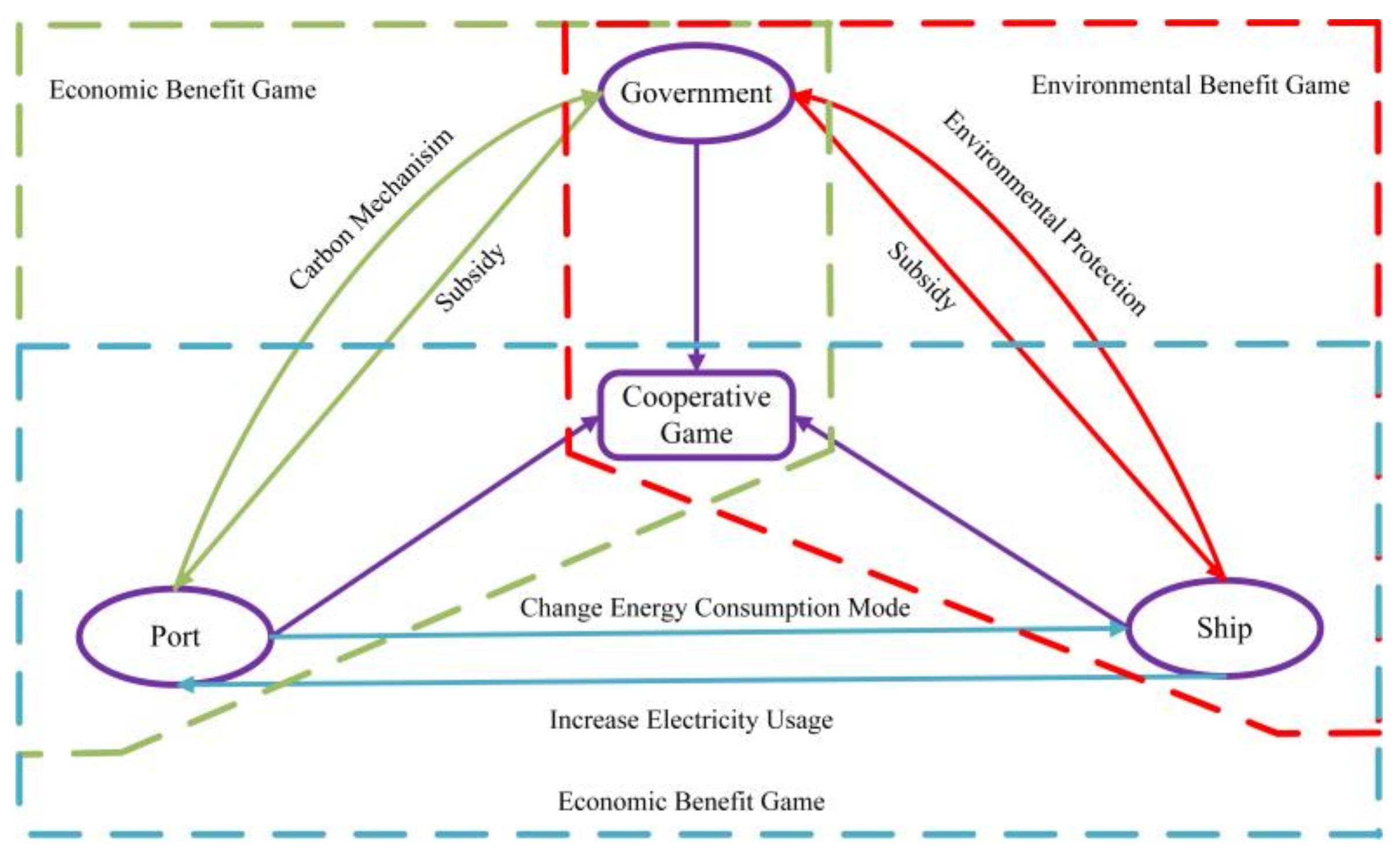
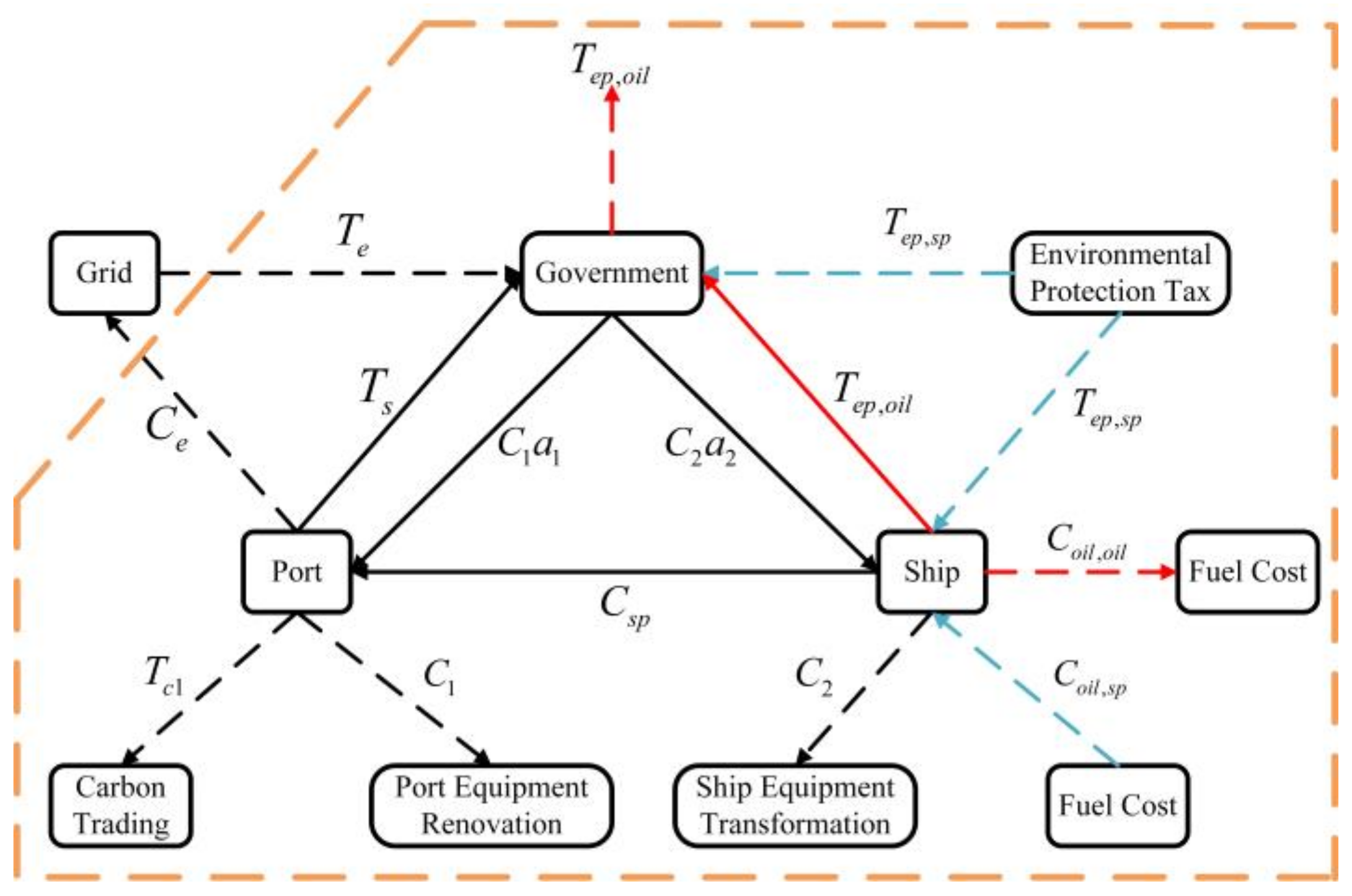
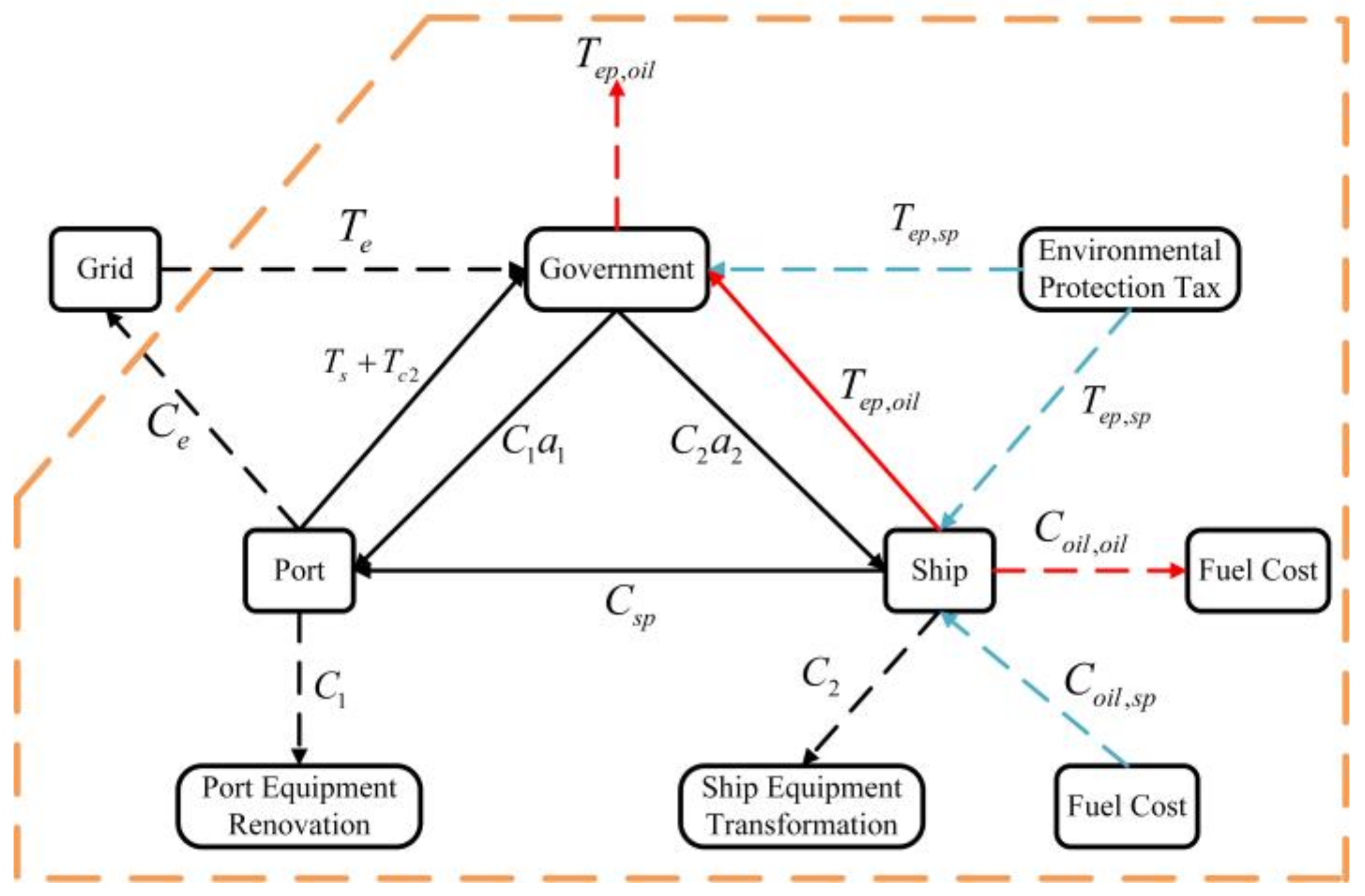
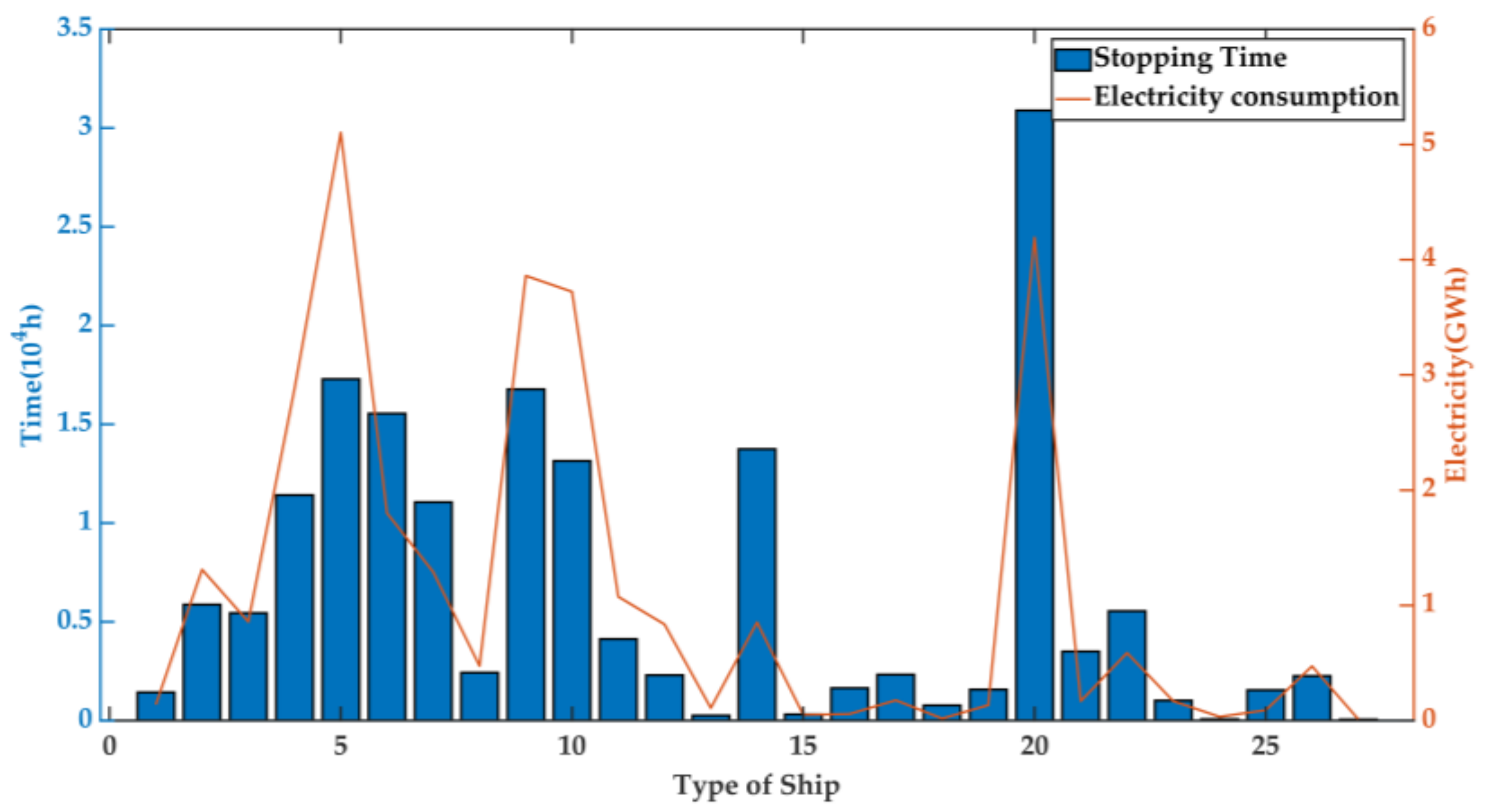
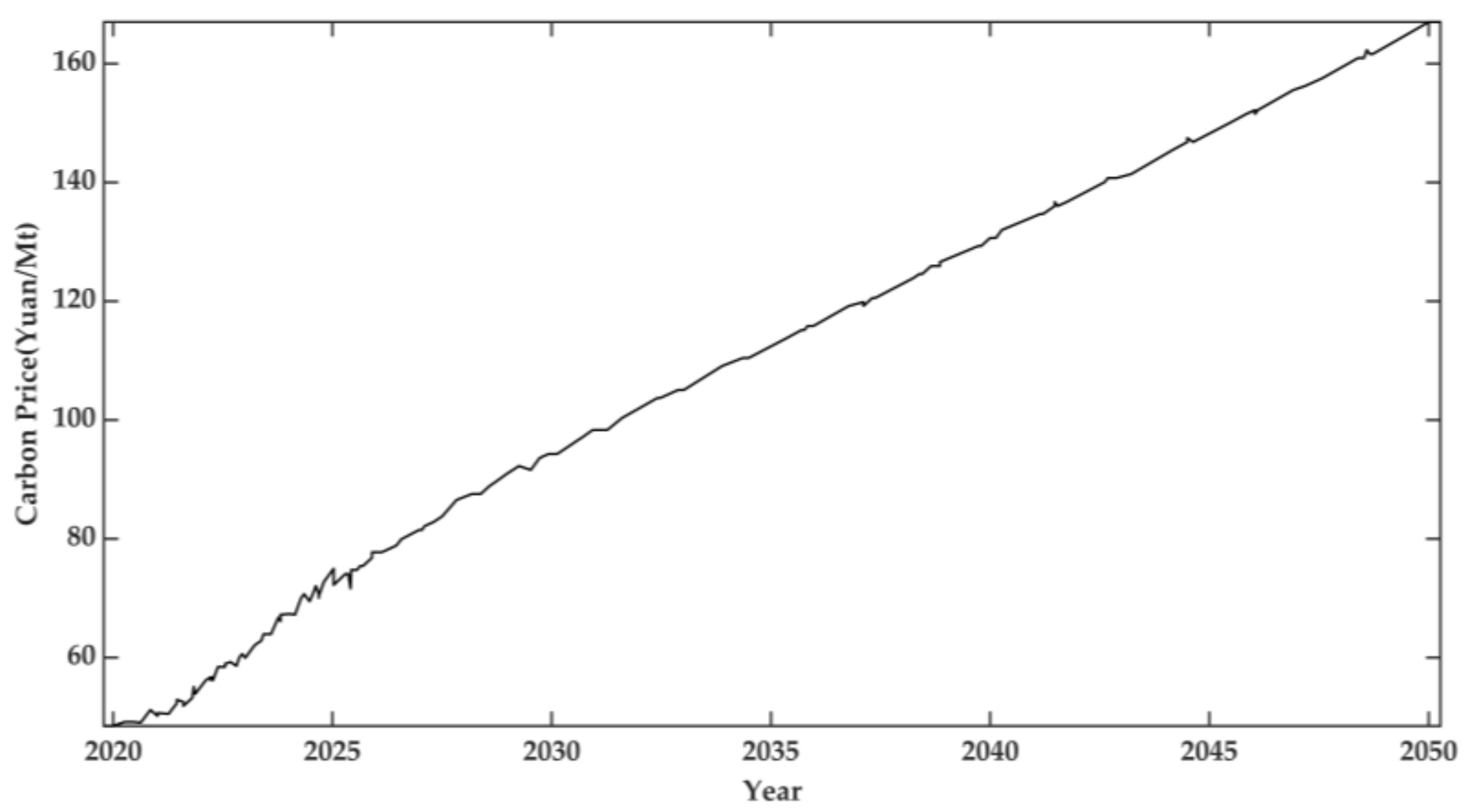
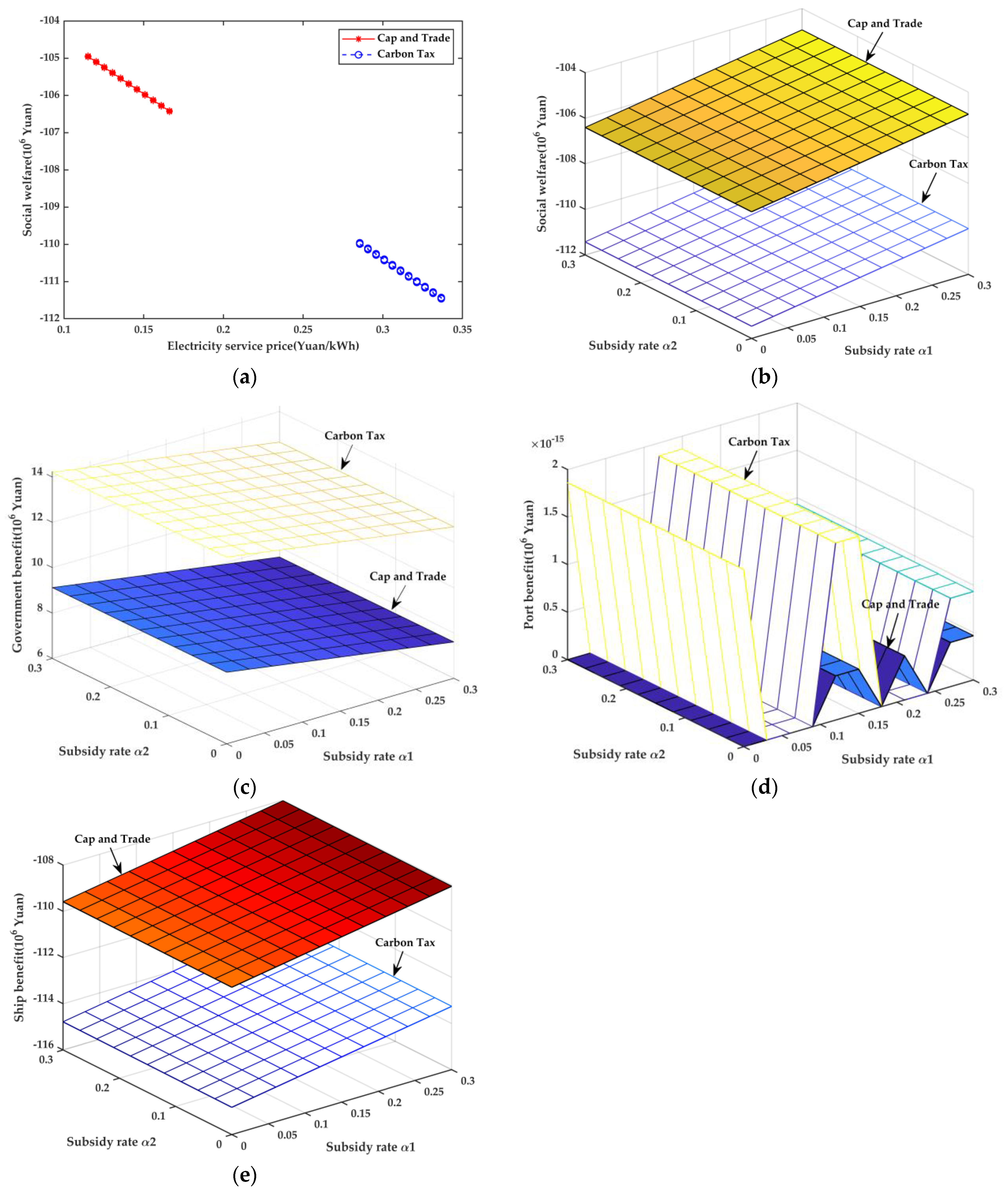
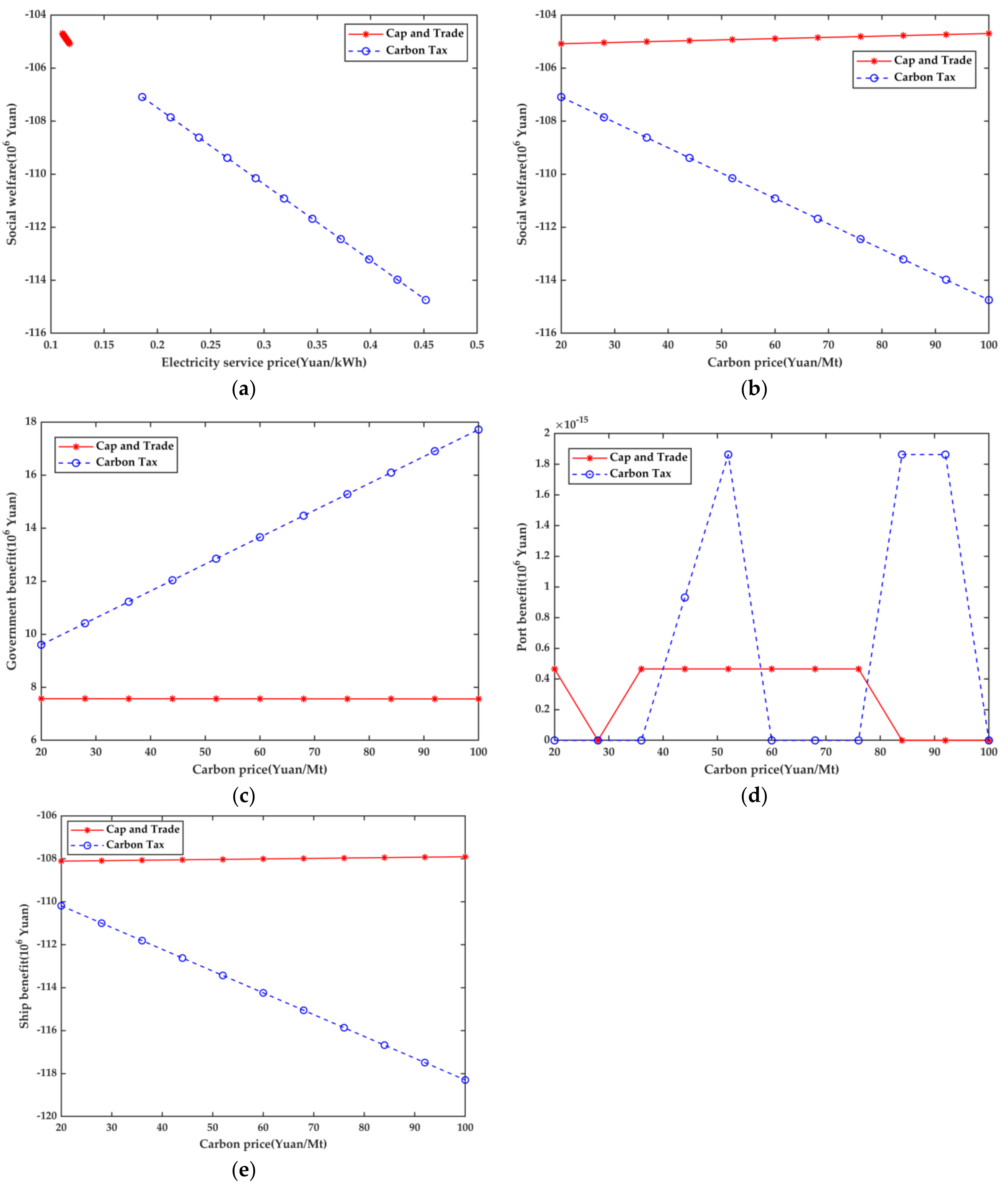
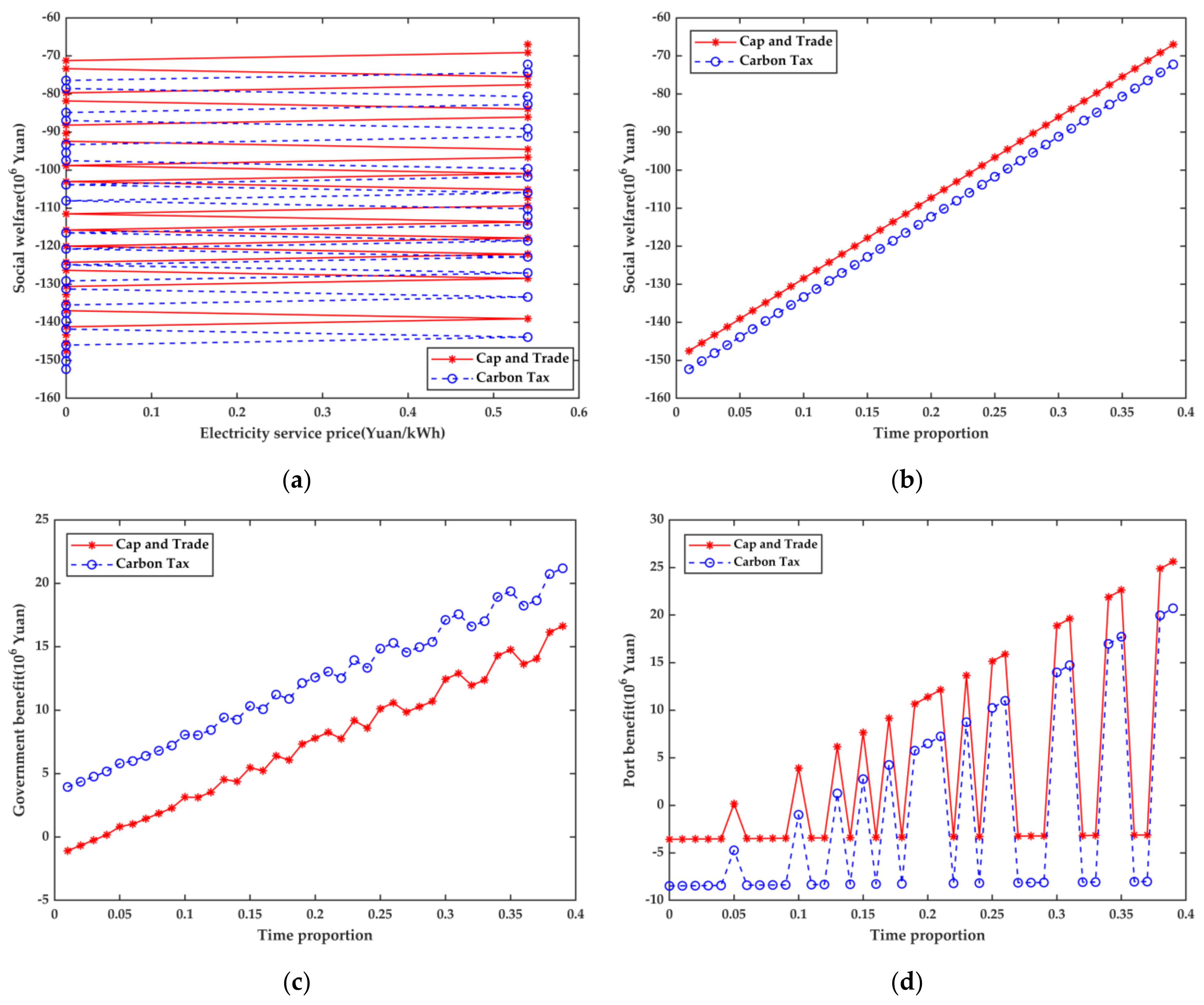
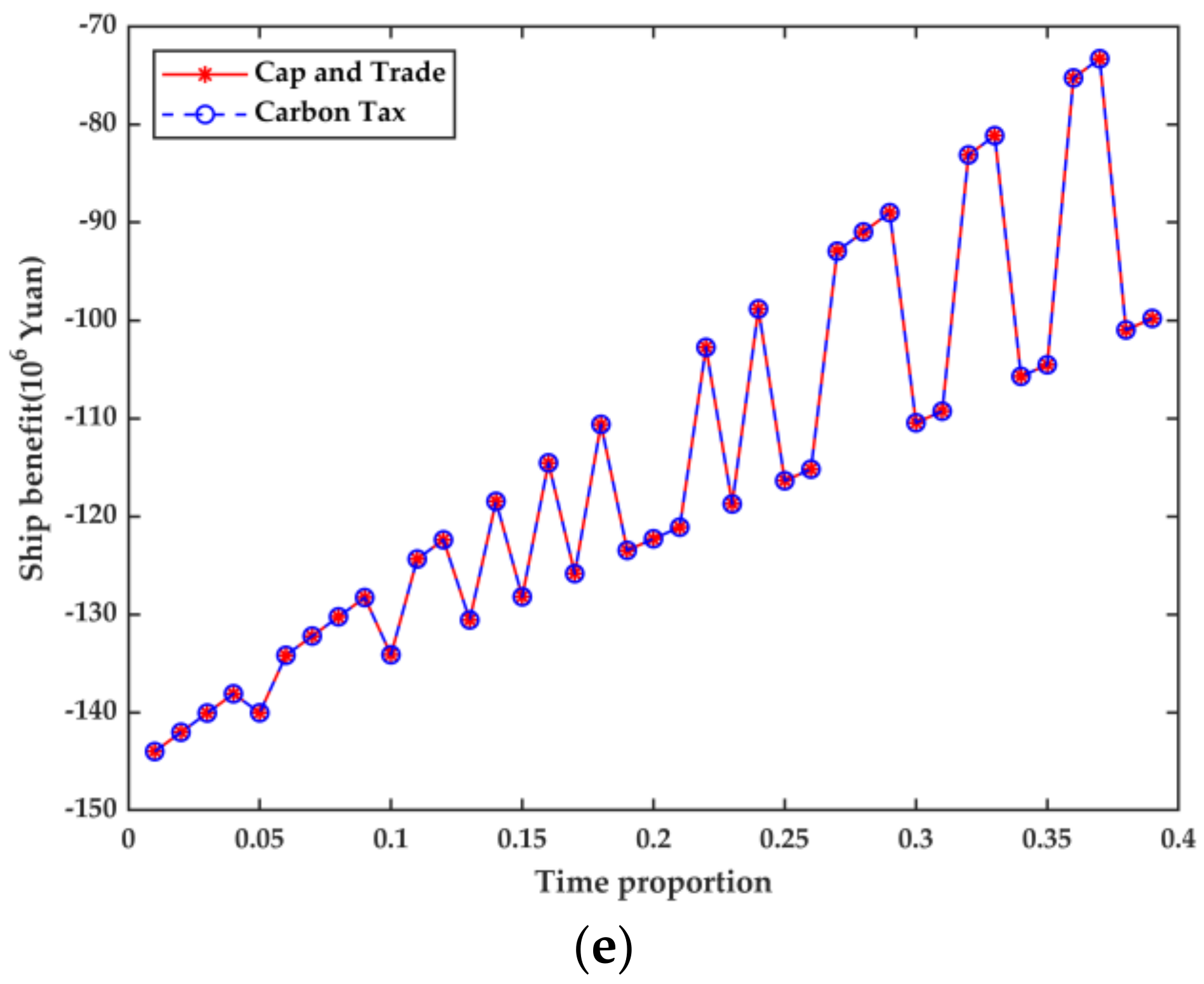
| Marine Fuel Emission Pollutants | ||
|---|---|---|
| SO2 | 0.46 | 0.95 |
| NOx | 11.80 | 0.95 |
| VOC | 0.53 | 0.05 |
| CO | 1.68 | 16.7 |
| general dust PM10 | 0.30 | 4 |
| CO2 | 698 | 5000 |
| Carbon Mechanism | Cap and Trade | Carbon Tax |
|---|---|---|
| Subsidy rate a1 (%) | 30 | 30 |
| Subsidy rate a2 (%) | 30 | 30 |
| Electricity service price (CMY/kWh) | 0.1151 | 0.2855 |
| Electricity actual price (CMY/kWh) | 0.7752 | 0.9456 |
| Electricity consumption (GWh) | 30.484 | 30.484 |
| Annual utilization hours (h) | 4692.8 | 4692.8 |
| Social welfare (million CMY) | −104.937 | −109.959 |
| Government benefit (million CMY) | 7.570 | 12.647 |
| Port benefit (million CMY) | 4.657 × 10−16 | 9.313 × 10−16 |
| Ship benefit (million CMY) | −108.031 | −113.228 |
| Savings from “oil-to-electricity” ships (million CMY) | 37.917 | 32.720 |
| Carbon Mechanism | Cap and Trade | Carbon Tax |
|---|---|---|
| Carbon cap (Mt) | 98,051.842 | |
| Carbon price (CMY/Mt) | 50 | 50 |
| Actual CO2 emissions (Mt) | 95,649.611 | 95,649.611 |
| Tax involved in carbon mechanism (million CMY) | −0.120 | 4.782 |
| Environmental tax savings (million CMY) | 6.100 | 6.100 |
| CO2 reduction (Mt) | 5209.746 | 5209.746 |
| SO2 reduction (Mt) | 14.023 | 14.023 |
| NOx reduction (Mt) | 359.713 | 359.713 |
| VOC reduction (Mt) | 16.157 | 16.157 |
| CO reduction (Mt) | 51.213 | 51.213 |
| General dust PM10 reduction (Mt) | 9.145 | 9.145 |
| Carbon Mechanism | Cap and Trade | Carbon Tax |
|---|---|---|
| Subsidy rate a1 (%) | 30 | 30 |
| Subsidy rate a2 (%) | 30 | 30 |
| Electricity service price (CMY/kWh) | 0.1109 | 0.1857 |
| Electricity actual price (CMY/kWh) | 0.7710 | 0.8458 |
| Electricity consumption (GWh) | 30.484 | 30.484 |
| Annual utilization hours (h) | 4692.8 | 4692.8 |
| Social welfare (million CMY) | −104.696 | −107.090 |
| Government benefit (million CMY) | 7.563 | 9.605 |
| Port benefit (million CMY) | 0 | 0 |
| Ship benefit (million CMY) | −107.904 | −110.186 |
| Savings from “oil-to-electricity” ships (million CMY) | 38.045 | 35.762 |
| Carbon Mechanism | Cap and Trade | Carbon Tax |
|---|---|---|
| Carbon cap (Mt) | 98,051.842 | |
| Carbon price (CMY/Mt) | 100 | 20 |
| Actual CO2 emissions (Mt) | 95,649.611 | 95,649.611 |
| Tax involved in carbon mechanism (million CMY) | −0.240 | 1.913 |
| Environmental tax savings (million CMY) | 6.100 | 6.100 |
| CO2 reduction (Mt) | 5209.746 | 5209.746 |
| SO2 reduction (Mt) | 14.023 | 14.023 |
| NOx reduction (Mt) | 359.713 | 359.713 |
| VOC reduction (Mt) | 16.157 | 16.157 |
| CO reduction (Mt) | 51.213 | 51.213 |
| General dust PM10 reduction (Mt) | 9.145 | 9.145 |
| Carbon Mechanism | Cap and Trade | Carbon Tax |
|---|---|---|
| Subsidy rate a1 (%) | 30 | 30 |
| Subsidy rate a2 (%) | 30 | 30 |
| Electricity service price (CMY/kWh) | 0.5399 | 0.5399 |
| Electricity actual price (CMY/kWh) | 1.2 | 1.2 |
| Proportion of time using shore power (%) | 39 | 39 |
| Electricity consumption (GWh) | 56.354 | 56.354 |
| Annual utilization hours (h) | 8675.2 | 8675.2 |
| Social welfare (million CMY) | −66.986 | −72.230 |
| Government benefit (million CMY) | 16.625 | 21.187 |
| Port benefit (million CMY) | 25.616 | 20.713 |
| Ship benefit (million CMY) | −99.796 | −99.796 |
| Savings from “oil-to-electricity” ships (million CMY) | 46.153 | 46.153 |
| Carbon Mechanism | Cap and Trade | Carbon Tax |
|---|---|---|
| Carbon cap (Mt) | 98,051.842 | |
| Carbon price (CMY/Mt) | 50 | 50 |
| Actual CO2 emissions (Mt) | 91,228.445 | 91,228.445 |
| Tax involved in carbon mechanism (million CMY) | −0.341 | 4.561 |
| Environmental tax savings (million CMY) | 11.276 | 11.276 |
| CO2 reduction (Mt) | 9630.913 | 9630.913 |
| SO2 reduction (Mt) | 25.923 | 25.923 |
| NOx reduction (Mt) | 664.978 | 664.978 |
| VOC reduction (Mt) | 29.868 | 29.868 |
| CO reduction (Mt) | 94.675 | 94.675 |
| General dust PM10 reduction (Mt) | 16.906 | 16.906 |
Disclaimer/Publisher’s Note: The statements, opinions and data contained in all publications are solely those of the individual author(s) and contributor(s) and not of MDPI and/or the editor(s). MDPI and/or the editor(s) disclaim responsibility for any injury to people or property resulting from any ideas, methods, instructions or products referred to in the content. |
© 2023 by the authors. Licensee MDPI, Basel, Switzerland. This article is an open access article distributed under the terms and conditions of the Creative Commons Attribution (CC BY) license (https://creativecommons.org/licenses/by/4.0/).
Share and Cite
He, Y.; Zhu, Y. Comprehensive Benefit Analysis of Port Shore Power Based on Carbon Trading. Energies 2023, 16, 2755. https://doi.org/10.3390/en16062755
He Y, Zhu Y. Comprehensive Benefit Analysis of Port Shore Power Based on Carbon Trading. Energies. 2023; 16(6):2755. https://doi.org/10.3390/en16062755
Chicago/Turabian StyleHe, Yang, and Yun Zhu. 2023. "Comprehensive Benefit Analysis of Port Shore Power Based on Carbon Trading" Energies 16, no. 6: 2755. https://doi.org/10.3390/en16062755
APA StyleHe, Y., & Zhu, Y. (2023). Comprehensive Benefit Analysis of Port Shore Power Based on Carbon Trading. Energies, 16(6), 2755. https://doi.org/10.3390/en16062755






